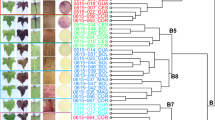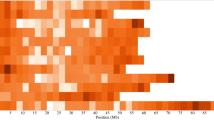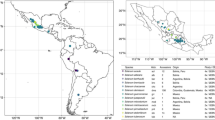Abstract
One of the basic research activities of genebanks is to partition stocks into groups that facilitate the efficient preservation and evaluation of the full range of useful phenotype diversity. We sought to test the usefulness of making intraspecific groups by replicated rapid visual intuitive impressions of coded plants by multiple uncoached observers. We invented the term “cog” (shorthand for cognate = “born together”) to indicate assumed genetic relatedness of cog members. All of the 16 populations of the wild potato species Solanum okadae in the genebank were thus examined in four separate grow-outs by up to seven genebank staff members, a total of 26 times. They were instructed to place them into two cogs defined only as big and not-big. Four populations were placed in the big cog for 70–90 % of observations, while all remaining populations but one were placed in the big cog for less than 5 % of observations. All populations were then assessed for DNA markers and various empirical traits. AFLP and SNP markers clearly distinguished the two cogs. The big cog populations were also distinguished from the others by virtue of having less foliar late blight resistance, more leaf hairiness, and lower tuber tomatine content. SNP similarity suggests one population of reputed Bolivian origin is really a mislabeled duplicate of another from Argentina. If so, the two cogs also perfectly align with country of natural origin, with big originating exclusively from Bolivia. Using S. okadae as a model, we demonstrated that rapid, simple, and inexpensive visual intuitive cogs reliably predict significant genetic and phenotypic differences. We propose testing the cog technique on other species and applying it as a new potato germplasm descriptor.
Resumen
Una de las actividades básicas de investigación de los bancos de germoplasma, es dividir los materiales en grupos que faciliten la preservación eficiente y la evaluación de la completa amplitud de diversidad de fenotipos útiles. Buscamos probar la utilidad de hacer grupos intra-específicos mediante impresiones rápidas, visuales, intuitivas, de plantas codificadas por múltiples observadores sin influencias. Inventamos el término “cog” (abreviación para cognate = “nacidos juntos”) para indicar relación genética asumida de números cog. Todas las 16 poblaciones de las especies silvestres de papa Solanum okadae en el banco de germoplasma fueron examinadas así en cuatro crecimientos separados por hasta 7 miembros del personal del banco de germoplasma, un total de 26 veces. Se les instruyó para ubicarlas en dos cogs definidos, solo grandes y no grandes. Se ubicaron cuatro poblaciones en el cog grande por 70–90 % de observaciones, mientras que todas las poblaciones restantes, excepto una, se ubicaron en el cog grande para menos del 5 % de las observaciones. Entonces todas las poblaciones fueron analizadas por marcadores de ADN y varios caracteres empíricos. Los marcadores AFLP y SNP distinguieron claramente los dos cogs. Las poblaciones del cog grande se distinguieron también de las otras por la característica de tener menos resistencia foliar al tizón tardío, más vellosidad en las hojas, y más bajo contenido de tomatina en el tubérculo. La similitud en los SNP sugiere que una población de origen asumido boliviano es realmente un duplicado etiquetado erróneamente de otro de Argentina. Si asi es, los dos cogs también se alinean perfectamente con el país de origen natural, con grande originándose exclusivamente de Bolivia. Usando S. okadae como modelo, demostramos que cogs visuales intuitivos rápidos, simples y baratos predicen confiablemente diferencias significativas genéticas y fenotípicas. Proponemos que se pruebe la técnica cog en otras especies y que se aplique como un nuevo descriptor de germoplasma de papa.




Similar content being viewed by others
References
Bamberg, J.B., and A.H. del Rio. 2007. The Canon of potato science– 50 topics in potato science that every potato scientist should know: 1) genetic diversity and gene banks. Potato Research 50: 207–210.
Bamberg, J. B. and A. H. del Rio. 2011. Diversity relationships among wild potato collections from seven “Sky Island” mountain ranges in the Southwest USA. American Journal of Potato Research 88: 493–499.
Bamberg, J. B., and A. H. del Rio. 2014a. Selection and validation of an AFLP marker core collection for the wild potato Solanum microdontum. American Journal of Potato Research 91: 368–375.
Bamberg, John, and Alfonso del Rio. 2014b. Intuitive visual impressions for identifying clusters of diversity within potato species. American Journal of Potato Research 91: 35.
Bamberg, J.B., A.H. del Rio, Z. Huaman, S. Vega, M. Martin, A. Salas, J. Pavek, S. Kiru, C. Fernandez, and D.M. Spooner. 2003. A decade of collecting and research on wild potatoes of the Southwest USA. American Journal of Potato Research 80: 159–172.
Bamberg, J.B., A. del Rio, and R. Moreyra. 2009. Genetic consequences of clonal versus seed sampling in model populations of two wild potato species indigenous to the USA. American Journal of Potato Research 86: 367–372.
Bamberg, J.B., A. del Rio, D. Douches, and J. Coombs. 2015. Assessing SNPs for predicting heterogeneity and screening efficiency in wild potato species. American Journal of Potato Research 92: 276–283.
Benforado, A. 2015. Unfair – the new science of criminal justice, 379 pp. NY: Crown Publishers.
Beveridge, W.I.B. 1980. Seeds of discovery, 130 pp. NY: WW Norton & Co.
Camadro, E., S.K. Saffarano, J.C. Espinillo, M. Castro, and P.W. Simon. 2008. Cytological mechanisms of 2n pollen formation in the wild potato Solanum okadae and pollen-pistil relations with the cultivated potato, Solanum tuberosum. Genetic Resources and Crop Evolution 55: 471–477.
Corballis, M.C. 2015. The wandering mind, 173 pp. Chicago: University of Chicago Press.
Doyle, A. Conan. 1894. The parasite, 112 pp. London: Constable & Co.
Freud, S. 1923. The ego and the Id. republished in English by Hogarth Press, 66 pp. London: Ltd.
Friedman, M., C.E. Levin, S.U. Lee, H.J. Kim, I.S. Lee, J.O. Byun, and N. Kozukue. 2009. Tomatine-containing green tomato extracts inhibit growth of human breast, colon, liver, and stomach cancer cells. Journal of Agricultural and Food Chemistry 57: 5727–5733.
Ghislain, M., D. Andrade, F. Rodriguez, R. Hijmans, and D. Spooner. 2006. Genetic analysis of the cultivated potato Solanum tuberosum L. Phureja group using RAPD and nuclear SSRs. Theoretical and Applied Genetics 113: 1515–1527.
Gladwell, M. 2005. Blink– the power of thinking without thinking, 277 pp. Boston: Little, Brown & Co.
GRIN. Germplasm Resources Information Network. 2016. https://npgsweb.ars-grin.gov/gringlobal/search.aspx.
Hardigan, M., J. Bamberg, C. Robin Buell, and D. Douches. 2015. Taxonomy and genetic differentiation among wild and cultivated germplasm of Solanum sect. Petota. The Plant Genome 8: 1–16.
Hawkes, J.G. 1990. The potato: evolution, biodiversity, and genetic resources, 259 pp. London: Belhaven Press.
Huaman, Z., R. Hoekstra, and J. Bamberg. 2000. The intergenebank potato database and the dimensions of available wild potato germplasm. American Journal of Potato Research 77: 353–362.
Jansky, S., J. Dawson, and D. Spooner. 2015. How do we address the disconnect between genetic and morphological diversity in germplasm collections? American Journal of Botany 102: 1–3.
Jarrett, C. 2015. Great Myths of the Brain, 333 pp. Great Britain: Wiley Blackwell.
Kahneman, D. 2011. Thinking, 499 pp. Farrar, Straus and Giroux, NY: Fast and Slow.
Konnikova, M. 2013. Mastermind: how to think like Sherlock Holmes, 288 pp. NY: Penguin.
Rohlf, F. J. 2008. NTSYSpc: Numerical Taxonomy System, ver. 2.20. Exeter Publishing, Ltd.: Setauket, NY
Sagan, C. 1977. The dragons of Eden, 271 pp. NY: Ballentine.
Skroch, P., J. Nienhuis, S. Beebe, J. Tohme, and F. Pedraza. 1998. Comparison of Mexican common bean (Phaseolus vulgaris L.) core and reserve collections. Crop Science 38: 488–496.
Spooner, D.M., and A. Salas. 2006. Structure, biosystematics, and genetic resources. In Handbook of potato production, improvement, and Post-Harvest Management, eds. J. Gopal, and S.M. Paul Khurana, 1–39. Binghamton, NY: Haworth Press, Inc.
Spooner, D.M., S.H. Jansky, and R. Simon. 2009. Tests of taxonomic and biogeographic predictivity: resistance to multiple disease and insect pests in wild relatives of cultivated potato. Crop Science 49: 1367–1376.
Spooner, D.M., M. Ghislain, R. Simon, S.H. Jansky, and T. Gavrilenko. 2014. Systematics, diversity, genetics, and evolution of wild and cultivated potatoes. Botanical Review 80: 283–383.
Stuessy, T. 2009. Plant taxonomy, 2nd edn, 539 pp. NY: Columbia University Press.
van den Berg, R.G., and N. Groendijk-Wilders. 2007. AFLP data support the recognition of a new tuber-bearing Solanum species but are uninformative about its taxonomic relationships. Plant Systematics and Evolution 269: 133–143.
Vos, P., R. Hogers, M. Bleeker, M. Reijans, T. van de Lee, M. Hornes, A. Fritjers, J. Pot, J. Peleman, M. Kuiper, and M. Zabeau. 1995. AFLP: a new concept for DNA fingerprinting. Nucleic Acids Research 23: 4407–4414.
Author information
Authors and Affiliations
Corresponding author
Rights and permissions
About this article
Cite this article
Bamberg, J., del Rio, A. & Navarre, D.A. Intuitive Visual Impressions (Cogs) for Identifying Clusters of Diversity within Potato Species. Am. J. Potato Res. 93, 350–359 (2016). https://doi.org/10.1007/s12230-016-9508-6
Published:
Issue Date:
DOI: https://doi.org/10.1007/s12230-016-9508-6




